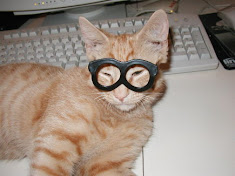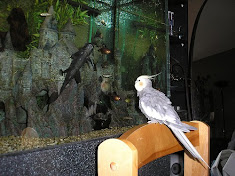 |
| White's Seahorse by Richard Ling |
Environment
Seahorses aren't your typical reef fish. Well, they're not your typical anything! They require a specialized environment to thrive in captivity. Rarely do they do well in your normal marine aquarium.
A seahorse aquarium needs to be a slow, peacefully environment. Their tankmates should be slow, and the water should be slow. As a general rule of thumb, seahorse keepers have the flow rate of their aquarium 3-5x/hr. What exact is this? It's the number of times per hour the entire volume of water "turns over" or moves through the pumps. For example, if you have a 20 gallon aquarium, and you want to have a 5x turnover, you would take 20 and multiply by 5. This would give you 100 gallons per hour turn over, and thus, the flow rate you are looking to achieve is 200gph. This can be through one 200gph pump, or through multiple smaller pumps, such as two 100 gph pumps or four 5gph pumps.
As I said, tankmates need to be slow as well. Seahorses are not very fast at catching food; some will stare at a piece for a good ten minutes before deciding it is edible. Highly aggressive, fast tankmates will usually end up stealing all the food. In addition, gregarious, fast moving fish tend to make seahorses nervous and can cause undue stress, which can lead to illness. Keep the tankmates slow and small, and your seahorse will be happiest. Or don't keep them at all, as many seahorse keepers discovered they do best only with their own kind. For specific recommendations, see the article on seahorse tankmates.
 |
| Pot-bellied Seahorse Couple by Nathan Rupert |
With that being said, no seahorse tank should be devoid of live rock. Live rock is still an important part of the miniature ecosystem you are attempting to create. What is important is balancing the volume of live rock with the open space needed. Tonga branch rock is one way of creating both hitching posts and providing live rock. Most seahorses enjoy other types of live rock to poke around in, looking for naturally occurring crustaceans to eat.
The size and shape of the aquarium is also important to seahorse health. 20 gallons per seahorse is the absolute minimum for a pair of seahorses. 40 gallons per pair of the really large ones such as H. ingens or H. abdominalis. However, water volume is only one factor when determining the best size seahorse aquarium. Seahorses need tall aquariums, as they are vertical swimmers. This is especially true if you plan to breed them. Minimum tank size is three times the total adult height of the seahorse. Be sure this is after you subtract the depth of your sand bed. A 20-inch tank with a 6 inch sand bed only gives seahorses 14 inches of usable height.
The last issue concerning the seahorse environment is water quality. Seahorses are messy eaters; consuming large volumes of high protein, high fat foods. They have an inefficient digestive system, which leaves the aquarist with high protein, high fat poops that break down in the aquarium. For this reason, it is important for the seahorse aquarist to watch their water quality closely, and set up their aquarium to deal with these waste-producing machines.
An efficient nutrient export system is a must. Nutrient export is simply put, a method of removing waste, either before it brakes down to nitrate and phosphate, or after. The simplest nutrient export system is large water changes, which physically removes the water with the waste, and replaces it with new water that does not have waste. However, water changes large enough and frequent enough to make a profound effect on nutrient remove are labor intensive and costly. Most aquarist, therefore, supplement regular partial water changes with other methods of nutrient export. Commonly used methods are protein skimming, refugiums and macroalgae for biological export, and nutrient absorbing pads.
Feeding
Seahorse keepers are obsessed with food. Live food, dead food, big food, small food. Why? Because our seahorses are so dependent on it.
 |
| Pink Seahorse by Nemo's Great Uncle |
Fortunately for aquarists, due to recent laws regarding the control of the number of seahorses traded internationally, captive bred seahorses are popular. Thankfully, they usually are grown on frozen food and have adapted early on to eat whatever is thrown in the aquarium. However, that doesn't entirely answer the problem of seahorse feeding. Many foods available on the market are not suitable as a staple diet for seahorse. Mysis, a popular frozen food for seahorses, is usually only available from freshwater sources. These sources do not have the right balance of fats appropriate for marine animals, and as a staple diet is likely to result in deficiencies as well as problems with accumulation of fatty tissue in the liver. Brine shrimp is virtually void of nutrition. Small krill, sometimes marketed as plankton, is a great food source, but many seahorses turn their noses up as they do not like the hard shell.
The same problems are encountered with live food. Ghost shrimp are typically freshwater and don't contain the right nutrition for saltwater fish. Brine shrimp are very poor nutritionally. Saltwater ghost shrimp and mysis are sometimes available but tend to be expensive because they have to be shipped from the cost.
So what is a seahorse keeper to do? Variety is the spice of life. While it may take time to convince your seahorse that mysis isn't the only thing they want to eat, most that eat frozen will learn to eat other shrimp like frozen food, such as krill. With live food, spend the money to get live saltwater shrimp and supplement. You can also enrich food with various supplements such as Vibrance or Selcon. Feeding live shrimp high quality foods to "gut load" for seahorses is another option.
Feeding should be done at least twice a day. As I said, in the wild they eat constantly. Fortunately for us, we can provide them with a high quality food where they can have a couple square meals a day and not force the aquarist to quit their job to ensure a constant supply of food. However they still need to be feed more often than most fish, and wouldn't do well missing feedings on a regular basis. It's also important to feed young seahorses more often, ideally 3-4 times a day as they grow.
For specific information on seahorse food items, see our seahorse food article.
Healthy Stock
Perhaps *the* most important factor in keeping seahorses is starting off with healthy animals. A big problem facing seahorse keepers is how rapidly their condition can decline, especially when you take into account the stress of transportation and acclimation can have seahorses. And unfortunately for aquarists, once their condition starts to decline, it is very hard to turn around. They also seem more susceptible to spreading disease among otherwise healthy individuals once they fall ill.
So what can you do to assure you are starting with healthy animals? The absolute best thing you can do is start with captive bred seahorses. They are by far the superior choice for longevity and health. They have been breed in captive conditions and are therefore acclimated to tank conditions. It is equally important, though, to get your captive bred seahorses from a reputable dealer. You want to be sure that the dealer isn't mixing them with wild seahorses, and ideally not with wild fish at all. While captive bred seahorses are much healthier individuals, some seem more susceptible to disease carried by wild fish, as they have never been exposed to "normal" pathogens.
 |
| Longsnout Seahorse by cliff1066 |
Purchase checklist:
- Active, moving around. Contrary to popular belief, seahorses rarely stay in one place and are moving around quite a bit.
- Bright, active eyes. A healthy seahorse will swivel its eyes around in constant search of food.
- Full, round belly. A healthy seahorse is a will feed seahorse. While they tend to be fairly thin by nature, any caved in sides is a bad sign.
- Clear fins.
- Cloudy eyes/dead stare (not much eye movement)
- Caved in sides, hollow looking plates.
- White, gray, or inflamed growths. Algae growth is normal, though.
- Heavy breathing/panting/coughing - Seahorses tend to breath heavier than most fish, though rocking back and forth from breathing so hard, or looking though they're coughing every few breaths is generally a sign of gill parasites or a seahorse being at death's door.
- Bloating. While a fat seahorse is a healthy seahorse, they also succumb to infections that cause fluid to accumulate under the skin. It can be difficult to tell the difference in the early stages, but watch for if it is still eating or not.
Things to avoid:
It may not always be possible to observe a seahorse before purchasing considering some of the best sources are online. Which is why it is so important to be sure to choose only a reputable dealer. If you do purchase online, be sure to watch for these traits right after purchase so you can notify the vendor if there are any problems with your newly acquired stock.
In addition to picking out healthy individuals, its important to pick species that will thrive in captivity, whether wild caught or captive bred. In general, the species that seem to be best suited to captivity are H. erectus, H. zoestrae, and H. reidi. Captive bred specimens of H. erectus and H. reidi readily eat frozen food. H. zosterae requires live food, but eats easy-to-hatch baby brine shrimp. All are fairly disease resistant. The wild caught specimens of these species tend to do will in captivity also, as long as you're willing to meet the specific wild caught requirements. H. reidi is difficult to train to frozen food, but as long as you're willing to feed it live food will thrive. H. erectus learn to eat frozen quickly, but you have to watch for parasites in wild caught individuals. The care for captive bred and wild caught H. zosterae is pretty much the same.
Once you have you're healthy stock, you need to keep it healthy. This means quarantining. Yes, this includes captive bred individuals, even though many breeders claim it isn't necessary. While most captive bred animals are in fact disease free, as claimed, you still need to make sure they didn't pick up any diseases at a distributor, etc . . . Quarantining new animals also gives you a chance to observe their eating habits in a quiet, close environment where they can't easily disappear into the decorations of the tank, or be out competed by established tank members. Quarantining should be done for a full 4 weeks, possibly longer in the case of wild caught seahorse. Many people ignore this advice until they lose their first tank to some highly contagious disease - myself included. Learn from our mistakes and ALWAYS quarantine. I cannot emphasis this point enough. Just do it!
While this just a basic overview of what is needed for keeping seahorses, (many a book has been written on the subject and still not everything is covered!) following these three keys will lead to a happy, healthy seahorse tank.
About the Author
Tami Weiss has been keeping seahorses for the past decade. For help and more information on seahorses and pipe fish see http://www.fusedjaw.com Articles, Photos, Videos, Discussions and more available.
Article Source: http://EzineArticles.com/?expert=Tami_Weiss
http://EzineArticles.com/?Keeping-Seahorses---Three-Keys-to-Success&id=1258070



0 comments:
Post a Comment